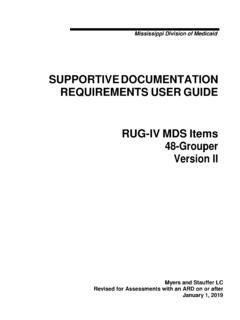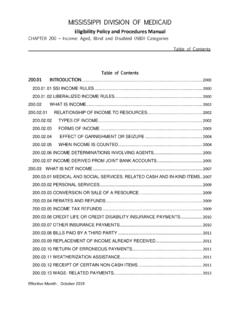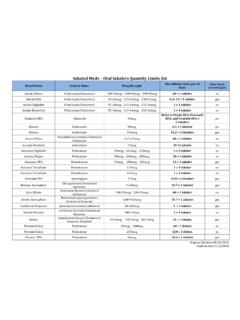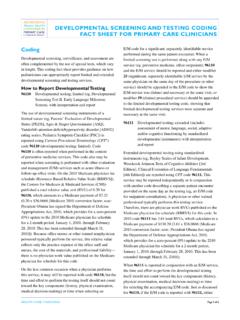Transcription of Early Periodic Screening, Diagnosis and Treatment
1 Early Periodic screening , Diagnosis and TreatmentProvider Documentation Training May 2017 Objectives MississippiCAN Program Information -Purpose, benefits and claims issues EPSDT Documentation Requirements-DOM Administrative Code Title 23: Part 223-Rule and Bright Futures Periodicity Schedule Provider Portal Provider Resources 2 Mississippi CAN PurposeThe Mississippi Division of Medicaid (DOM) has implemented a managed care program called Mississippi Coordinated Access Network (MississippiCAN). MississippiCAN is designed to get a better return on Mississippi s health care investment by improving the health and well-being of Medicaid beneficiaries. MississippiCAN is a statewide coordinated care program designed to meet the following goals: -improve beneficiary access to needed medical services,-improve quality of care, and-improve program efficiencies as well as cost has contracted with two coordinated care organizations (CCOs), Magnolia Health and UnitedHealthcare Community Plan, responsible for providing services to beneficiaries who participate in the MississippiCAN program.
2 There are certain beneficiaries that will qualify for this program, both mandatory and optional beneficiary CAN BenefitsMississippiCAN administers the Medicaid benefit package, as defined by the state of Mississippi, to Medicaid Community Plan provides additional benefitsTo MississippiCAN members: Unlimited doctor visits Care management Member outreach Health education Well and sick care Home care and supplies Transportation and more!View benefit details at: >For Health Care Professionals>Mississippi Go to review a patient s eligibility or benefits, check claims status, submit claims or review Directory of Physicians, Hospitals and other Health Care Services 877-743-8734 Hours of Operations:Monday Friday 8 to 5 is an automated system. Please have your National Provider Identifier number andyour Tax ID or the member ID ready, or you may hold to speak to a representative.
3 Thecall center is available for care providers to: Answer general questions Verify member eligibility Check status of claims Ask questions about your participation or notify us of demographic and practice CAN Claims IssuesAdministrative Code Overview6 Download the entire Administrative Code: initial or established age appropriate medical screening which must include at a minimum:7 Rule : EPSDT ScreeningsComprehensive health and developmental history including assessment of physical and mental health development & family unclothed physical examination. Appropriate immunizations according to ACIP, and specific to age and health historyLaboratory tests adhering to AAP Bright Futures Periodicity Schedule (BFPS) Sexual development and sexuality screening adhering to the AAP BFPSH ealth education, including anticipatory guidance.
4 MINIMUM EPSDTSCREENING REQUIREMENTSRule : Adolescent CounselingAdolescent counseling and risk factor reduction intervention to include Diagnosis with referral to an enrolled Mississippi Medicaid provider for Diagnosis and Treatment for defects COUNSELING According to Bright Future and Preventive Medicine coding fact sheet , 99401 should not be billed on the same date of service as 99381-99385 and 99391-99395. It can be billed in addition to E/M codes 99201-99215. CPT 99401 DEPRESSION SCREEN Annually, ages 12-21 CPT 96160 (effective 1/1/2017)Rule : Developmental ScreeningsDevelopmental screening or surveillance to include Diagnosis with referral to an enrolled Mississippi Medicaid provider for Diagnosis and Treatment for defects assessment to include Diagnosis with referral to an enrolled Mississippi Medicaid provider for Diagnosis and Treatment for defects discovered.
5 Bright Futures calls for developmental screening at 9, 18, and 30 months. CPT 96110 Document interpretation in E/M visit note. Modifier -25 may be attached to associated E/M visit. Examples: Ages and Stages Questionnaire (ASQ)Parents Evaluation of Developmental Status (PEDS)Survey of Well-Being of Young Children (SWYC) Bright Futures calls for autismspecific screening at 18 and 24 months. CPT 96110 Example: Modified Checklist for Autism in Toddlers (MCHAT) has been recently revised to MCHAT-R. Social/Emotional & Behavior Screensare recommended at everywell visit. CPT 96127- brief emotional/behavioral assessment with scoring and documentation, per standardized instrument Examples: Ages and Stages Questionnaire Social Emotional (ASQ-SE)Pediatric Symptom ChecklistBehavior Assessment Scale for Children 2ndEd (BASC-2) Rule.
6 Vision and hearing ScreeningsVision screening , at a minimum, to include Diagnosis with referral to an enrolled Mississippi Medicaid optometry or ophthalmology provider for Diagnosis and Treatment for defects screening , at a minimum, to include Diagnosis with referral to an enrolled Mississippi Medicaid audiologist, otologist, otolaryngologist or other physician hearing specialists for Diagnosis and Treatment for defects CPT 99173 Vision screening is required at ages 3, 4, 5, 6, 8, 10, 12, 15 years old and a risk assessment for all other ages from newborn to 21. CPT 92551 hearing screening is required at ages 4, 5, 6, 8, 10, once between 11 & 14, 15 & 17, and 18 & 21. There should also be a hearing screening for newborn and 3-5 day visit. Risk assessment should be performed for all other : Dental ScreeningDental screening , at a minimum, to include Diagnosis with referral to an enrolled Mississippi Medicaid dental provider for beneficiaries at eruption of the first tooth or twelve (12) months of age for Diagnosis and referral to a dentist for Treatment and relief of pain and infections, restoration of teeth and maintenance of dental FUTURES ORAL HEALTH After tooth eruption, fluoride varnish may be applied to all children every 3 6 months in the primary care or dental office.
7 D0145: Oral Evaluation and Counseling D1206: Fluoride Varnish ApplicationCan be billed twice per fiscal, at least 5 months apart, for patients between 6 months up to 3 years old. CPT requires a MD, NP or DO to perform; no RN or : Documenting EPSDT Screenings12 Beneficiary and family history with appropriate updates at each screening visit, including, but not limited to, the following:a) Psychosocial/behavioral history,b) Developmental history, andc) Immunization , as appropriate, including, but not limited to:a) Newborn blood screening , bilirubin b) HIV screeningb) Vaccine administration, if indicated,c) Hematocrit and/or hemoglobin,d) Lead screening and testing,e) Tuberculin test, if indicated,f) Dyslipidemia Screening, g) Sexually transmitted infection/disease screening , 7h) Cervical dysplasia screening , and other pertinent lab and/or medical tests, as guidance, including, but not limited to.
8 A) Safety,b) Risk reduction,c) Nutritional assessment,d) Supplemental Nutrition Assistant Program (SNAP) and Women, Infants and Children (WIC) status, ande) Adolescent counseling, including but not limited to:1) Reproductive health,2) Substance abuse,3) Relationships,4) Coping skills, and5) Physical ExaminationLengthHeightWeight BMIB lood PressureHead CircumferenceOral HealthVisionHearingDevelopmental/behavio ral assessment, as appropriate, including:a) Developmental screening to include, but not limited to:1) A note indicating the date the test was performed,2) The standardized tool used which must have:Motor, language, cognitive, and social-emotional developmental domains,(b) Established reliability scores of approximately orabove,(c) Established validity scores of approximately or above for the tool conducted on a significant amount of children and using an appropriate standardized developmental or social-emotional assessment instrument, and(d) Established sensitivity/specificity scores of approximately or above, and3) Evidence of a screening result or screening score,b) Autism Screening, c) Developmental surveillance,d) Psychosocial/behavioral assessment,e) Alcohol and drug use assessment, andf)
9 Depression results of the tests or procedures or an explanation of the clinical decision to not perform a test or procedure in accordance with the AAP Bright Futures Periodicity Schedule MUSTbe the specific age appropriate screening requirements according to the AAP Bright Futures Periodicity Schedule. Sample Documentation Form13 EPSDT Documentation Forms for ALL ages are available for download on DOM s website: TO ALSO DOCUMENT Appropriate referral(s) to other enrolled Mississippi Medicaid providers for Diagnosis and Treatment . Follow-up on referral(s) made to other enrolled Mississippi Medicaid providers for Diagnosis and scheduled EPSDT screening appointments, missed appointments and any contacts or attempted contacts for rescheduling of EPSDT screening appointments. (see Administrative Code 223 Rule )IMPORTANT NOTE: Medical records must be available to the Division of Medicaid and/or designated entity upon request.
10 [Refer to Maintenance of Records Part 200, Rule ]Source: Miss. Code Ann. 43-13-117, 43-13-118, 43-13-121, : Revised to correspond with SPA 2015-017 (eff. 11/01/2015), eff. 10/01 : Documenting EPSDT ScreeningsMost Common Documentation Issues15 Immunization Status not documented. screening for sexually transmitted diseases are not documented. No hemoglobin or hematocrit levels. No lead assessments and no blood lead testing when applicable. No nutritional counseling. No developmental assessments. Missing height/weight growth parameters. No documentation a hearing or vision screening . Missing documentation of anticipatory guidance. No dental referrals. No documentation of the periodicity appointment (return appointment for the next scheduled EPSDT visit). No documentation for the additional evaluation and management visit reimbursed.











